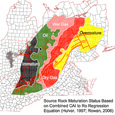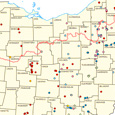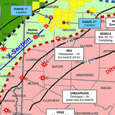Glossary of Terms
A B C D E F G H I J L M N O P R S T U V W Y
A
Abandonment Costs- The money spent to abandon a well or production facility, including plugging a well, removing well equipment and surface remediation.
Access Road- A road that leads to a well pad during well production.
Annulus- A void between piping, tubing or casing and the piping, tubing or casing surrounding it.
Appalachian Basin- A geological formation associated with the Marcellus and Utica shales that contains potential shale gas resources.
Aquifer- An underground layer of water-bearing rock or gravel, sand or silt.
B
Backflow- During well testing, fluid may flow from one zone to another due to the wellbore’s pressure rising higher than other zone pressures.
Bcf- Billion cubic feet; used to measure natural gas; Bcf/D denotes a daily measure of natural gas in billions of cubic feet
Blowout- When formation fluids, like water, gas, oil or a mixture of the three, flow uncontrolled from a well.
Blowout Preventer (BOP)- A large valve at the top of a well that workers can close if control of formation fluids is lost. By closing this, workers can increase mud density, then open the BOP and regain pressure control of the well.
Bonus Consideration- Monetary incentive given to the mineral rights owner by the lessee for signing an oil, gas and mineral rights lease.
Borehole- A generalized term for a shaft bored into the ground.
Brine- Water that has a higher salt content than normal seawater.
Brownfield- An existing onshore or offshore facility.
C
Cap the Well- A phrase that means gaining control of a well blowout by placing a valve on the wellhead.
CAS- Chemical Abstracts Service.
Casing- A large pipe that is inserted into a recently drilled borehole, typically held into place with cement.
Clean Water Act- Federal law that regulates discharges into waterways.
Coalbed Methane (CBM)- Unconventional natural gas that is extracted from coal beds.
Compressor Station- Located along natural gas pipelines, these facilities compress gas to a certain pressure to keep the gas moving along the pipeline.
Condensate- A gas that condenses into a liquid when pumped to the surface; an ultralight oil.
Conductor Casing- Prevents collapse of the loose soil near the surface of a borehole.
Conventional Natural Gas Reservoir- Highly permeable rock formation that holds natural gas as it is trapped by an overhead impermeable rock layer.
Corrosion Inhibitor- A chemical compound that decreases the corrosion rate of a metal or an alloy.
Cryogenic Plant- Processes natural gas and condenses it to a liquid state using low temperatures. Hydrocarbons can then be separated and the gas can be more easily transported after processing.
Curtailment- A reduction in gas deliveries due to supply shortage or demand that has exceeded a pipeline’s capacity.
Cuttings- Pieces of rock that are displaced by the drill bit as the rock is cut.
D
Darcy’s Law- An equation that describes the flow of liquid through a porous medium.
Derrickman- The rig crew member that works with the drill pipe; a derrickman is typically second to the driller.
Downstream- The refining, processing, purifying, marketing and distribution of oil and gas products; the pipeline that receives oil or gas from another pipeline.
Drilling Mud- A fluid used to aid the drilling of boreholes.
Drillpipe- Steel tubes with threaded ends that connect rig surface equipment to the drill bit and bottomhole assembly. The drillpipe pumps drilling fluid to the bit and moves the bit and bottomhole assembly.
Drilling Rig- Typically large standing structure that creates holes in the ground. Sometimes referred to as a “Christmas tree” when lit up at night.
Drill String- The drill pipe, bottomhole assembly and other tools used to make the drill bit turn at the bottom of a wellbore.
Dry Gas- Natural gas that is mostly made up of methane.
Dry Hole Clause- If the first well drilled is “dry,” this clause requires the lessee to drill another well, usually within a specified time frame.
E
Easement- A right of use of someone else’s land.
Eductor- Often called a “hoot-n-nannie”; A device placed in a system to allow chemicals to be blended at a faster rate. Also allows for much better blending than pouring directly into the fluid. Term submitted by Robert Tillman
Eminent Domain- The right of the government to take private property for public use.
Ethane Cracker- Processing plant that takes ethane and breaks it down by heat to create ethylene, which is a base chemical for plastics.
EPA- Environmental Protection Agency.
EPCRA- Emergency Planning and Community Right-to-Know Act.
Estimated Ultimate Recovery (EUR)- The approximate amount of oil or gas that is potentially recoverable or has already been recovered from a well.
F
Feedstock- A raw material, such as natural gas or natural gas liquids, that will be further processed.
FERC- Federal Energy Regulatory Commission; regulates, monitors and investigates the interstate transmission of natural gas, oil and electricity, as well as natural gas and hydropower projects.
Fishing Tool- The device used to retrieve equipment that is lost down the well.
Flowback- Water that is pressurized and used during the fracking process returns to the surface through the well after fracking is completed.
Flaring- Controlled burning of natural gas at the well site. Temporary flares are used during well production testing, and small amounts of natural gas are burned if the natural gas can’t be processed.
Forced Pooling- Legal concept that allows drillers to extract natural gas beneath the land of property owners who refuse to sign a lease or cannot be located, as long as enough surrounding property owners have signed leases.
Fracking- See Hydraulic Fracking or Fracturing.
Fracking Fluid- Fluid that is pumped into injection wells at high speeds to fracture underground rock formations and release natural gas. The fluid is mostly composed of water.
Frac Tank- This is where the water or the proppant is held while a well is being fractured.
Friction Reducer- An additive that reduced the friction of a fluid as it flows through small spaces.
G
Geological Formation- A portion of earth material that has distinct characteristics and homogeneous physical properties.
Granting Clause- Defines the rights of the lessees and lessors, including the lessee’s development rights, under the lease.
Greenfield- A new field that requires new facilities, either onshore or offshore.
Groundwater- Water located beneath the surface of the earth.
GWPC- Ground Water Protection Counsel.
H
Hedging- An investment strategy used to offset potential losses or gains.
Horizontal Drilling- The process by which a well is drilled horizontally to reach more of the formation. Horizontal drilling allows for more fractures through which natural gas can escape than a traditional, vertical well could.
Hydraulic Fracking or Fracturing- Usually shortened to ‘fracking’, the process of using high pressured fluid containing water, sand and chemicals into sub-surface rock formations. The fluid fractures the rocks, improving the flow of natural gas into the well bore. Early attempts at injecting fluids into wells began in the 1860s, but early attempts at fracking didn’t occur until 1947. The fracking process of today began in 1999.
Hydrocarbon- Chemicals made up of hydrogen and carbon, such as methane.
Hydrology- The study of water.
I
Impact Fee- A well fee for unconventional gas extraction; the funds from the fee are distributed to local and state governments.
Injection Well- There are 5 classes of injection wells. Class 2 is reserved for the oil and gas industry across the country. Injection wells are used to dispose of liquid oilfield brine — the liquid that comes up to the surface when the oil and gas is produced. Injection wells put the brine back into the ground to maintain reservoir pressure.
Intermediate Casing- Used on longer drilling intervals. Set after the surface casing and before the production casing. Prevents caving of weak or abnormally pressured formations.
IOGCC- Interstate Oil and Gas Compact Commission.
J
Joint Venture- A business agreement between companies that decide to develop a new entity and assets by contributing equity; sometimes abbreviated ‘JV’
L
Landman- A person who acquires mineral rights from landowners for oil and gas exploration companies.
Lease- An area of land on which exploration or production activity occurs; the act of acquiring land for exploration or production activity.
Lessee- The company that is permitted to drill and develop the oil and natural gas minerals beneath the landowner’s property.
M
Marcellus Shale- A rock formation that extends from the base of the Catskills in New York and extends southwest to West Virginia, Kentucky and Ohio.
Marginal Well- A well that is nearing the end of profitable production due to either depleted resources or low productivity.
Market Enhancement Clause- Similar to Post Production Costs, but with emphasis on how deducted costs increase the value of the natural gas produced from the well. Protects the landowner from having deductions taken out of royalty payments that don’t improve the price of gas directly.
Maturation- The stage of a source rock after it has been exposed to certain pressures and temperatures to make it able to produce oil or gas.
Mcf- Thousand cubic feet; used to measure natural gas.
Midstream- The transportation, storage, and marketing of oil and gas products.
Mmcf- Million cubic feet; used to measure natural gas.
MSDS- Material Safety Data Sheets.
N
Natural Gas- Natural gas is a naturally occurring gas mixture consisting of methane and other hydrocarbons. It’s used as an energy source to heat buildings, generate electricity and recently, to power motor vehicles.
NGL- Natural gas liquid, such as butane or propane.
NGWA- National Ground Water Association.
NORM- Naturally occurring radioactive elements like uranium, radium and radon that are dissolved in very low concentrations during normal reactions of water with rock or sand. Term submitted by Joe Calhoun
O
ODNR- Ohio Department of Natural Resources.
On-site Water Treatment- Treatment units that recycle flowback fluids that can be used again for fracking.
P
Paid up Lease- Delay rentals are paid in advance with the bonus consideration for the lease’s entire term.
Payout- Refers to the time when all of the costs associated with leasing, exploring, drilling and operating have been covered by a well or wells’ production.
Permeability- A measure of the ability of a material to allow fluids to pass through it.
Petrochemical- Of or relating to petroleum or natural gas substances, including refining and processing.
Pigging- A device inserted into a pipeline for cleaning purposes. It has blades or brushes that clean rust, wax, scale and debris.
Pig Launcher- A device that pushes a pig through a pipeline for cleaning purposes. Term submitted by Joe Calhoun
Pig Receiver- A device that receives a pig after it has been sent through a pipeline.
Pooling or Unitization- A provision that allows landowners to combine land to form a drilling unit.
Post Production Costs- Costs such as transportation, processing, dehydration, storage and marketing that occur between the point of production and the point of sale of oil and natural gas.
Primary Term- The length of a lease in years.
Produced Water- Naturally occurring water that comes to the surface during the fracking process.
Production Casing- The final interval in a well. The smallest casing, it forms the outer boundary of the annulus.
Proppant- A material that keeps a fracture open. A proppant can be gel, foam or slickwater-based.
Proved Reserves- Estimated volumes of hydrocarbon resources that are considered to be recoverable under existing economic and operating conditions. For natural gas, the estimates of total recoverable natural gas. For oil, petroleum that data estimates to be commercially recoverable.
R
Rathole- The temporary storage space that is used to store the drill pipe while adding a new section of pipe to the drill string at some drilling rigs.
Reclamation- The restoration of a well site to its condition prior to drilling operations.
Refinery- A processing plant where crude oil is refined into usable products, like gasoline.
Refracking- The process of restimulating a well after its initial production.
Rental Clause- Defines the lessee’s responsibilities during the primary term.
Reservoir- An area that contains a resource. In fracking, well operators are seeking to tap into natural gas reservoirs deep underground.
Roughneck- A drilling crew member; ranked between a roustabout and derrickman.
Roustabout- An unskilled worker on a well site that completes a range of tasks; ranks below a roughneck.
Royalty- A payment received by the lessor from the oil or gas company, based on the production of the well and market prices.
S
Secondary Term- Indefinite period of time after the primary term.
Severance Tax- A tax imposed when non-renewable resources, like natural gas and crude oil, are extracted.
Shale- Shale is a fine-grained sedimentary rock that is formed from compacted mud. Black shales sometimes breakdown to form natural gas or oil.
Shale Gas Play- A geographic area that has mostly consistent geographical characteristics and potentially contains an accumulation of natural gas.
Shut-in Royalty- A payment to the lessor in lieu of a production royalty. This is received when a well cannot produce due to production problems.
Snubbing- Putting drillpipe in a wellbore when pressure is contained. During this process the blowout preventers (BOPs) are closed.
Surface Casing- A pipe that protects fresh-water aquifers and it also provides structural strength so that other casings may be used.
Surface Water- Water that naturally occurs on land, like lakes, streams, rivers and reservoirs.
Surfactant- Compounds that lower the surface tension of a liquid.
Sweet Spot- The area of a shale play or reservoir that has the best production or best possible production.
T
Tcf- trillion cubic feet; used to measure natural gas.
Temporary Cessation Clause- Near the end of the primary term, the lessee is permitted to complete operations.
Termination- The end of a lease.
Throughput- The amount of material passing though a system per day.
Tight Gas- Natural gas that is contained between dense rock layers that prevent it from flowing easily.
Tract- A single, individually taxed parcel of land.
TRI- Toxics Release Inventory.
U
Underground Injection Well- An underground steel and concrete-encased shaft that deposits hazardous waste by force.
Unsaturated Zone- A zone where the soil and the rock contains air as well as water in its pores. It’s above the groundwater table. The unsaturated zone doesn’t contain readily available water, but it does provide water and nutrients to the biosphere.
Upstream- Includes finding shale locations, drilling and operating wells; the development and production of gas; the equipment, facilities or systems located in the wellbore before the surface choke.
Utica Shale- A natural gas containing rock formation below the Marcellus Shale. The Utica Shale formation extends from eastern Ohio through much of Pennsylvania to western New York.
V
Vadose Zone- The layer of earth between the land’s surface and the position of groundwater is at atmospheric pressure.
VOC- Volatile organic compound.
W
Wellhead-The part of the production well that provides pressure control.
Well Pad- A single location on which multiple wells are drilled.
Wet Gas- Natural gas that contains methane like dry gas, but also contains butane and ethane. These compounds, called natural gas liquids (NGLs), can be separated and sold individually.
Wellbore- The drilled hole including the open or uncased portion of the well.
Wildcat- Refers to a lease, well or operator that is not yet proven, so it includes a significant risk.
Y
Y-grade- A raw mix of natural gas liquids; NGLs aren’t separated to the purity of product of gasoline. Term submitted by Joe Calhoun




